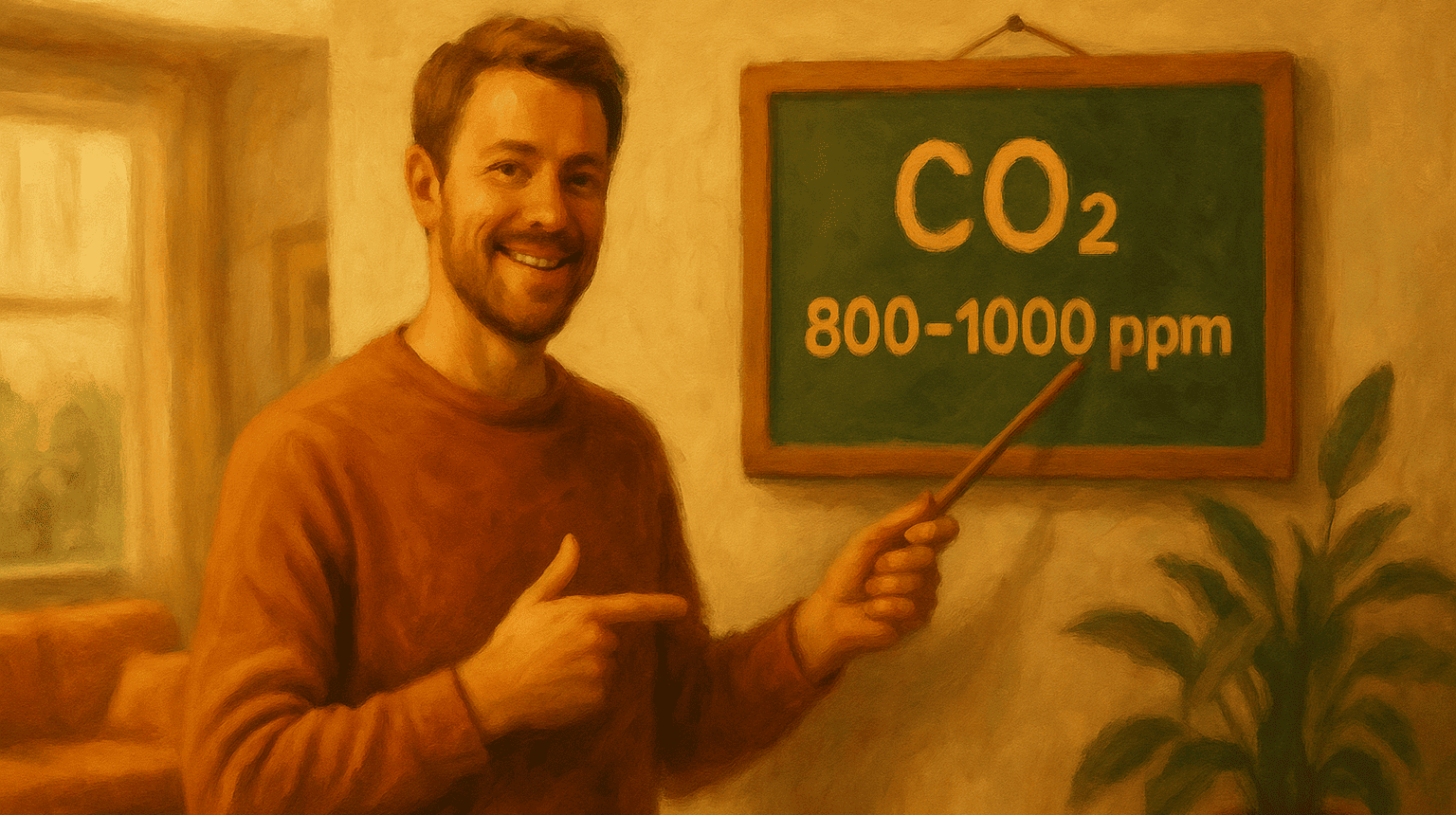
Updated on:
Aim for about 800–1,000 ppm while rooms are occupied. Short peaks above 1,000 ppm are normal, but if levels stay around 1,500–2,000 ppm, bring in more outdoor air. Workplace limits (5,000 ppm over 8 hours) are legal ceilings, not comfort or cognition targets for home or office.
CO2 ranges
~420–430 ppm
- Feels like: Fresh outdoor baseline
- What to do: Use as your benchmark
<800 ppm
- Feels like: Great ventilation
- What to do: Keep routine airing or mechanical OA
800–1,000 ppm
- Feels like: Acceptable for most homes
- What to do: Crack a window; verify supply air
1,000–2,000 ppm
- Feels like: Stuffy; sleep/focus dip
- What to do: Ventilate now; reduce crowding
2,000–5,000 ppm
- Feels like: Headache/fatigue more likely
- What to do: Increase outdoor-air setpoint; find blockages
5,000 ppm
- Feels like: Regulatory limit (workplaces)
- What to do: Treat as a fault at home
30,000 ppm
- Feels like: Short-term ceiling (workplaces)
- What to do: Leave the area; diagnose the source
40,000 ppm
- Feels like: Immediately dangerous
- What to do: Evacuate; call emergency services
What the authorities actually say about CO2
OSHA and NIOSH publish exposure limits for workers (5,000 ppm 8‑hour TWA; 30,000 ppm 15‑minute STEL; IDLH at 40,000 ppm). Those numbers protect against acute harm—they are not comfort targets for homes.
ASHRAE standards focus on ventilation rates rather than a single “CO2 limit.” Europe’s REHVA uses a practical traffic‑light approach: <1,000 ppm (green), 1,000–2,000 (yellow), and >2,000 (red).
Why do bedrooms spike CO2 overnight, and why does it matter?
Closed windows + people breathing for 7–9 hours = rising CO2. Lowering bedroom CO2 via a small window crack or increased outdoor air improves sleep and next‑day alertness in field studies.
How to avoid high levels of CO2
1) Ventilate now (fast drop): open a window or enable outdoor air for 5–15 minutes; cross‑vent if you can.
2) Measure (confirm): use an NDIR CO2 monitor at breathing height; log bedtime → wake‑up to see peaks.
3) Prevent (steady state): ensure HVAC brings in outdoor air; use kitchen/bath exhausts; avoid unvented combustion indoors.
4) Rentals / budget: night‑purge before sleep; keep a door undercut; use a simple box‑fan to exchange air.
How to measure CO2
• Prefer NDIR sensors. Avoid ‘eCO2’ from VOC chips for decision‑making.
• Don’t place monitors in a breath plume, in the sun, or directly over a vent.
• Benchmark: Measure outdoors first, then rooms for one evening and one overnight.
Edge cases & vulnerable groups
• Infants, older adults, pregnancy, migraine, asthma, or sleep apnea: keep closer to 800–1,000 ppm in bedrooms.
• Basements and rooms near gas appliances: ventilate proactively; avoid unvented combustion.
CO2 monitor usage tips
• CO (carbon monoxide) ≠ CO2. CO is deadly at low ppm; install CO alarms and go outside if anyone gets a headache or dizziness.
• If a monitor shows tens of thousands of ppm, evacuate and call emergency services (possible CO2 release).
CO2 FAQ
What is a safe CO2 level indoors?
Around 800–1,000 ppm during occupancy. Sustained levels of >1,500–2,000 ppm mean you need more outdoor air.
What causes high CO2 at home?
People in closed rooms, low outdoor‑air intake, crowded spaces, and unvented combustion (gas stoves, candles, and fireplaces).
What’s normal in a bedroom?
Outdoors sits near ~425 ppm (2025). Closed‑window bedrooms often reach 1,200–2,500 ppm by morning.
Do air purifiers lower CO2?
HEPA purifiers remove particles, not gases. To cut CO2, bring in outdoor air or use specialized sorbents.
Can CO2 build up in a closed room?
Yes—quickly, with multiple people and low air exchange.
Does humidity affect CO2?
Not directly. Both rise with occupancy; fix ventilation and manage RH for comfort (≈40–50%).
